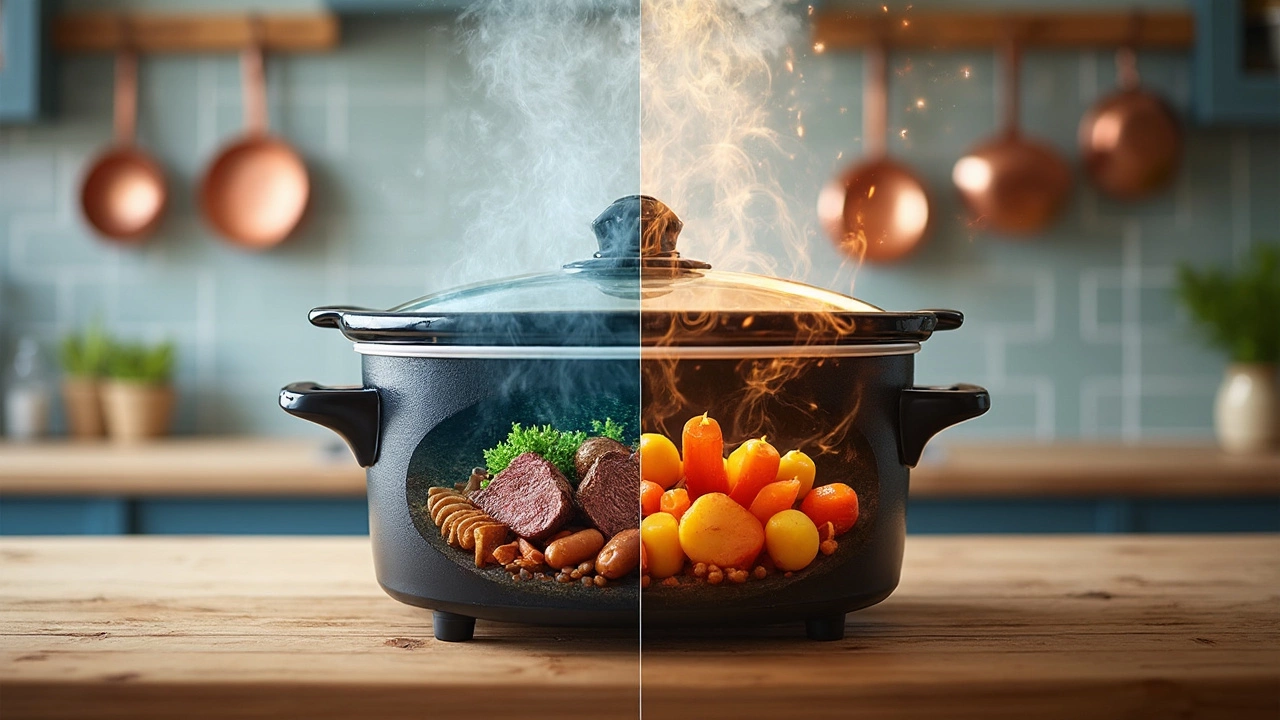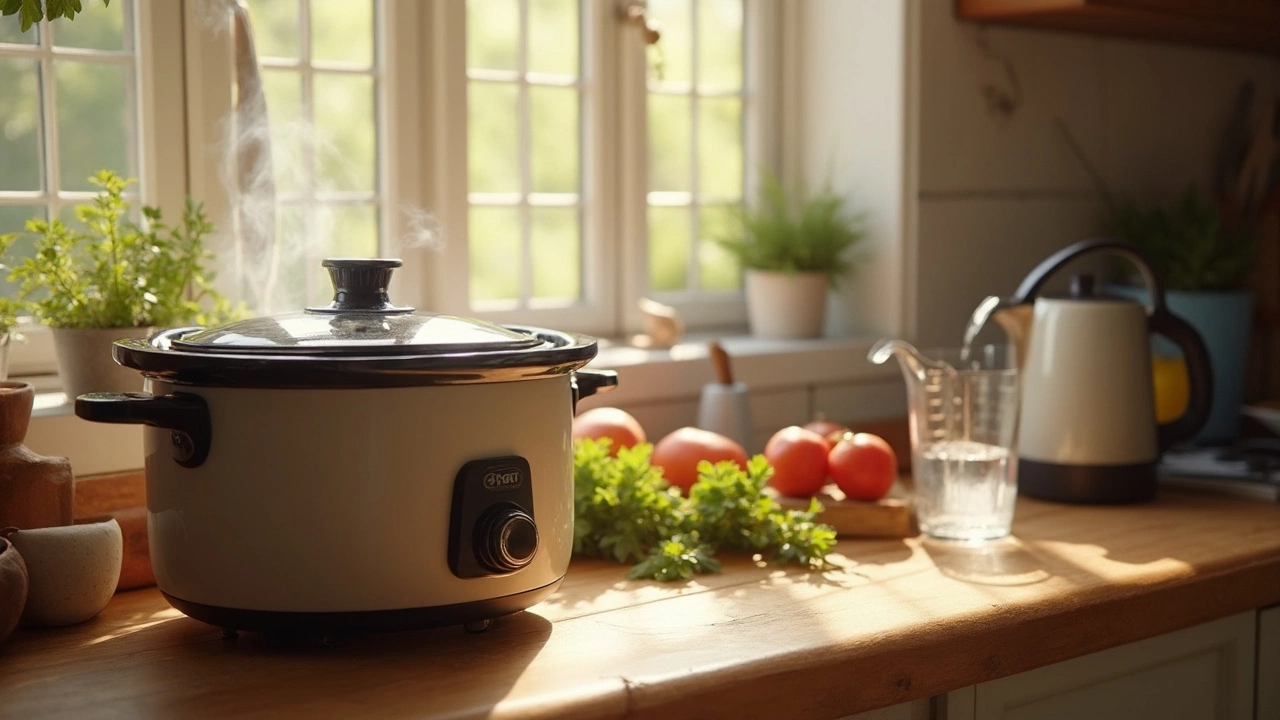So you’ve got the pot ready, your ingredients chopped, and the recipe out. But here’s the question nobody asks until they’re standing at the sink: should you fill your slow cooker with cold water or boiling water?
It makes a bigger difference than you might think. Water temperature doesn’t just change how fast your stew comes together. It impacts how flavors develop, how safe your meal is, and even how your veggies hold up after hours of cooking. I’ve messed up more beef roasts than I’d like to admit (don’t ask Elara about that New Year’s Eve mess). Once I figured this out, things got much easier, and a lot tastier.
First thing you need to know: most slow cooker recipes are written with cold or room-temperature water in mind. That’s what the timing assumes. But there are times when starting hot actually throws the timing off or messes with your flavors. Want the details? Let’s break down exactly what happens when you tweak the temperature from the very start.
- What Happens When You Start With Cold Water
- Boiling Water: Speeding Things Up or Ruining the Dish?
- Safety and Flavor: It’s Not Just About Heat
- Time-Saving Hacks and Pro Tips
What Happens When You Start With Cold Water
Most slow cooker recipes want you to start with cold or room-temperature water. There’s a reason: slow cookers are designed to gradually heat everything up together, so flavors mingle and tough cuts of meat break down just right. When you fill your pot with cold water and turn it on low, it usually takes around an hour or so for your ingredients to hit a steady simmer.
This slow ramp-up does more than just stretch out your dinner time. It gives proteins—like chicken and beef—the right amount of time to soften and get tender. You’ll notice that when you stick to cold water, your roasts stay juicy instead of drying out. Veggies like potatoes and carrots come out fork-tender but don’t turn to mush.
There’s a safety side to it, too. Starting with cold or cool water means your slow cooker brings everything up to a safe cooking temperature together, evenly. Food safety folks like the USDA say that when you throw in hot food or boiling water, you risk parts of your meal sitting in the “danger zone” (between 40°F and 140°F) for too long. That’s where bacteria can throw a party. Slow but steady heating is actually safer.
If you’re using a slow cooker to prep meals in advance—like chili or soup—you can even assemble everything in the pot the night before, stash it in the fridge, and pop it in to start cold the next morning. That’s a real time-saver, especially on busy weekdays.
Boiling Water: Speeding Things Up or Ruining the Dish?
Tossing in boiling water might sound like a shortcut, but it can actually mess with your slow cooker results more than you’d expect. The big idea behind these gadgets is slow, even heat—let the flavors develop while everything gently simmers. If you dump in boiling water from the start, your cooker skips that gentle ramp-up. That messes with how the flavors blend and, honestly, it can wreck certain cuts of meat and turn veggies mushy way too soon.
Let’s look at why. Almost all slow cookers are built to heat food up gently, passing through the “danger zone” (between 40°F/4°C and 140°F/60°C) fast enough for safety, but not so fast that it cooks everything unevenly. Add already-boiling water and you risk overcooking the outside of things before the inside even catches up. Plus, the collagen in tough cuts of meat needs time at around 160°F–180°F (71°C–82°C) to break down into gelatin—not a blast of hot water that leaves shreds instead of tender bites.
I found a good way to think about it from America’s Test Kitchen. They said:
“Starting with hot liquid can cause proteins to seize up and vegetables to soften too quickly, resulting in a one-note dish... Slow cooking is really about patience and letting everything come together gradually.”
It’s not just about the science, either. Real cooks find their favorite chili or stews just don’t taste the same when rushed. In fact, the magic of a slow cooker comes from that gentle climb in temperature, nudging all those spices and aromatics together slowly. It’s why your house smells amazing halfway through a long cook.
There is one place boiling water can help: preheating your slow cooker. Some people pour in the boiling water just for five or ten minutes, then toss it out before loading the food—especially handy if you’re starting with frozen meat and want to speed things up safely. But don’t cook with the boiling water still inside, or you risk messing up the recipe’s timing and texture.
Here’s a handy side-by-side of what happens with different water temps:
| Water Temp | Effect on Dish | Result |
|---|---|---|
| Cold/Room-temp | Standard, slow heating | Balanced flavors, tender texture, safe timing |
| Boiling | Immediate high heat | Mushy veggies, tough meat, off timing |
If you’re tempted to speed things up, it’s usually better to just use the “High” setting on your slow cooker for a while rather than throw in boiling water. That way you’re still working with the cooker, not against it.

Safety and Flavor: It’s Not Just About Heat
Let’s get real for a second—using a slow cooker isn’t just about leaving your dinner to bubble away for hours. You’ve got to think about food safety, especially with meats. The USDA says food needs to pass through the “danger zone” (that’s 40°F to 140°F, or about 4°C to 60°C) quickly so bacteria don’t get a party going in your casserole. The longer your food stays cool, the bigger the risk.
Lots of people figure, just dump in boiling water and skip the risk. Sounds smart, but it’s not quite that simple. Starting with boiling water in your slow cooker ramps up the internal temp too fast. That can throw off your cooking times and actually lead to overcooked edges and a mushy mess in the middle—especially if you’re making stews or soups where you want tender chunks, not baby food puree.
On the flip side, dumping cold water on cold meat isn’t ideal either. The solution? Use room-temperature or lukewarm water. That helps ingredients heat evenly and hover in the safe zone without a taste sacrifice. Plus, vegetables hold their shape better, and you keep those nice, slow flavor builds that make slow-cooked meals so rich.
Here’s a snapshot showing how water temperature impacts cooking and food safety in slow cookers:
| Water Temperature | Heating Speed | Flavor Impact | Food Safety |
|---|---|---|---|
| Cold | Slow | Deep flavor, but meat may sit in danger zone longer | Risky if meat is thick/cold |
| Room-temp/Lukewarm | Moderate | Good flavor, even texture | Safest overall |
| Boiling | Fast | Flavors may get harsh, texture can go mushy | Safe, but timing for doneness is tricky |
One more tip: If you’re using frozen meat, thaw it first. Frozen chunks keep everything cold for way too long and open the door to bacteria. Every slow cooker manual I’ve ever read says this in bold print, and for good reason.
Bottom line? Safe and tasty slow cooking isn’t just about cranking the heat. It’s about letting everything warm up just right so flavors blend and food stays safe. That’s where the magic happens.
Time-Saving Hacks and Pro Tips
Juggling a busy day and craving that slow-cooked comfort dinner? Here are some actual tricks to make the most out of your slow cooker without cutting corners on taste or safety.
If you’re short on time, preheat your slow cooker. It sounds basic, but it’s a total game changer. Just plug it in and set it on high while you prep your ingredients. That way, the pot is already hot when the food goes in, shaving up to 30 minutes off the overall cook time. This hack is great for dishes with meat or dense veggies that usually take longer to warm up.
Another handy move: use boiling water only for recipes that specifically call for it, like when you’re cooking dried beans. Starting with boiling water can help get beans up to a safe temp quickly, since undercooked beans (like kidney beans) contain a toxin called phytohemagglutinin that needs high heat to break down. For most other recipes, though, stick to cold or room-temperature water unless you want mushy veggies or weird textures.
- Slow cooker inserts are oven-safe up to 400°F (check your brand). If you want to brown meat or caramelize onions, do it on the stove or in the oven, then transfer everything into the cooker. This boosts flavor and makes everything taste like it simmered for hours.
- Layer smartly – put tougher ingredients (like potatoes and carrots) at the bottom, and quicker-cooking stuff at the top. The hot spot’s at the bottom.
- Check the liquid. Slow cookers don’t let much steam escape, so you usually need less water or broth than in stovetop recipes. If you’re converting a recipe, try reducing liquid by one-third to avoid a soupy mess.
Here’s a table to help you decide which water temp and approach to use for different common slow cooker recipes:
| Recipe Type | Water Temp to Start | Best Hack |
|---|---|---|
| Chili/Stews | Cold/Room Temp | Preheat cooker, brown meat first |
| Dried Beans | Boiling | Boil for 10min first, then slow cook |
| Chicken/Braised Dishes | Cold/Room Temp | Layer meat on top, veggies below |
| Soups | Cold/Room Temp | Reduce broth by 1/3, add pasta late |
And one more tip: don’t be tempted to open the lid too often. Every time you peek, you let out about 15–20 minutes’ worth of heat, which drags out the cook time. Trust the process—your food won’t burn unless all the water is gone.

